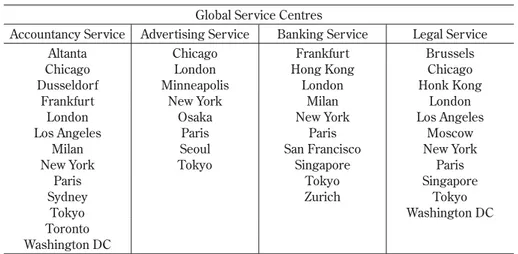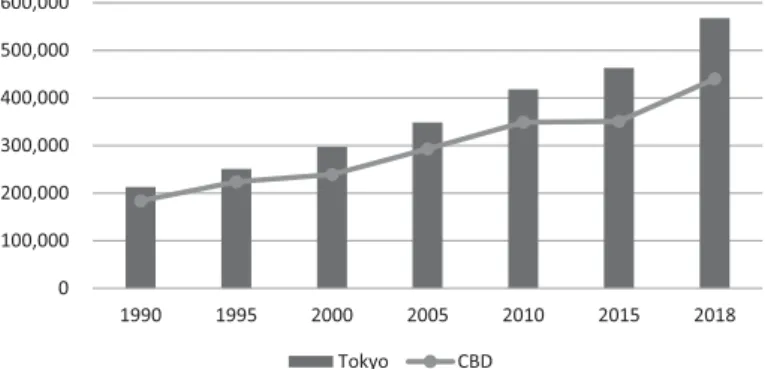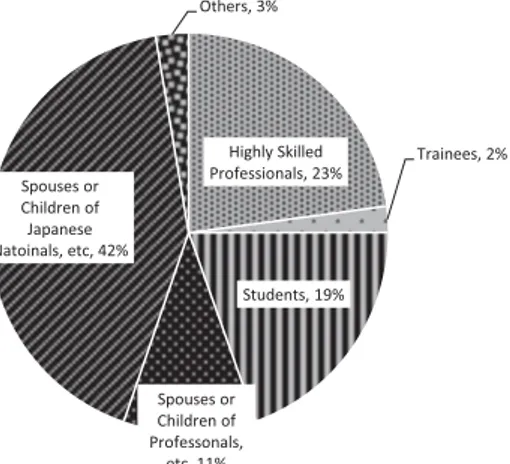Globalization by Immigrants: The Case of Tokyo
Eriko H
IRAIWA§1. Introduction
Economic globalization has a significant impact on international labor migration and urban spaces, and hence, immigration in major cities continues to be an important issue, including for Japanese cities. Cities have been a focal point of international transactions and have attracted domestic as well as international migrants. Researchers have analyzed changes in urban economies, politics, and culture, as well as ethnic diversity, as the growth of agglomeration in cities has been accompanied by an increase in immigrants. Cities and immigrants continue to play an active role in shaping economic and social structures, including not only residential spaces and educational institutions but also labor laws, trade, politics, and networks with other countries. Examples of such cities include New York, London, and Tokyo, as Sassen argued in The Mobility of Labor and Capital [1988] and The Global City [1991] from a political-economy approach. Sassen’s analysis of cities linked contemporar y globalization in cities with immigration. The central questions in her works on global cities and the world economy were “What is the role of major cities in the organization and management of the world economy?,” “In what ways has the consolidation of a world economy affected the economic base and associated social and political order in major cities?,” “What happens to the relationship between state and city under conditions of strong articulation between a city and the world economy?” She illustrated increased globalization alongside continued concentration and control of such a global network.
As centers of finance and global servicing and management, New York, London, and Tokyo rose in prominence. At the same time, “the spatial dispersion of production, including its internationalization, has contributed to the growth of centralized service nodes for the management and regulation of the new space economy” [Sassen 1991: 330]. Tokyo is portrayed as one such core space where global activities, such as foreign direct investment, have been concentrated and international financial markets have formed, resulting in the spatial dispersion of production.
§The author acknowledges financial support from Nanzan University Pache Research Subsidy I ― A ― 2 for the 2020
2. Literature Review
Sassen’s argument about how immigrants and the resultant changes in processes expand city space also illustrates economic restructuring and social geography. Immigrants play a crucial role in global cities by providing unskilled labor for low-wage service and manufacturing jobs. This insight suggests that Tokyo experiences a new economic and social process where a new space for natives and immigrants is developed along with an increase in foreign labor. As global cities are characterized by a growing concentration of economic activities [Sassen 1991], this study argues how Tokyo has changed its role in terms of a global city. In the process of reforming Tokyo as a global city, there is a lack of extensive research on immigration or immigrants and how they are connected with the space. More specifically, the approach toward migration in the context of a global city, such as Tokyo, and how migrants influence the economic and social development of such cities should be explored. After Sassen’s efforts, scholars have applied the concept of global city to specific cities. These scholars include Hamnett [1994], who explored Sassen’s claims about changes in economic processes in cities, which leads to growing polarization of the occupational and income structures, including high levels of immigration. Beaverstock et al. [1999] and Taylor et al. [2014] reviewed Sassen’s works and employed the concept of globalization of economic activity and the organization of advanced producer services to provide a measure of a city’s global capacity or world-cityness. By reviewing the literature and examining the major cities identified as world cities in terms of four key services ― accounting, advertising, banking, and law (Table 1) ― they identified lower levels of world-cityness other than London, New York, Paris, and Tokyo. It is suggested that the geography of global service centers has been unevenly organized, proceeding in three regions: North America, Western Europe, and Pacific Asia [Beaverstock et al. 1999]. Tokyo is listed as a prime city in all categories of global economic activities such as accountancy, advertising, banking, and legal services.
Table 1 World Cities by Corporate Service Criteria Global Service Centres
Accountancy Service Advertising Service Banking Service Legal Service
Altanta Chicago Frankfurt Brussels
Chicago London Hong Kong Chicago
Dusseldorf Minneapolis London Honk Kong
Frankfurt New York Milan London
London Osaka New York Los Angeles
Los Angeles Paris Paris Moscow
Milan Seoul San Francisco New York
New York Tokyo Singapore Paris
Paris Tokyo Singapore
Sydney Zurich Tokyo
Tokyo Washington DC
Toronto Washington DC
Newbold [2004] explores the spatial effects of Chinese immigration on New York through their assimilation. That study demonstrates that “where they live matters”; in other words, space modifies the assimilation process. Moreover, immigrants arriving in a country at the same time but in different places (New York, San Francisco, and Los Angeles) have divergent assimilation experiences [Newbold 2004: 212]. Newbold [2004] describes the assimilation differentials between the metropolitan areas as differences in human capital, the growth of high-tech industries, and the economic, social strength, and size of the immigrants. The discussion does not include a globalization impact of the economy across countries, but these processes would be deeply related to the expansion and rapid growth in the global economy, which requires agglomeration of the headquarters of occupational management. Associated with these industrial transformations, global cities also need growth in the producer services industry, which makes them a magnet for immigrants.
Studies on structural changes in global cities have recognized immigration as a force that determines the space of cities geographically, socially, and economically [Wright and Ellis 2000]. Recent studies exploring the social and structural changes in global cities have also recognized migration as promoting processes other than globalization and institutional factors [Shi 2017]. These findings call for a reconstruction of globalization and demonstrate that immigrants are culturally, economically, and spatially changing cities significantly [Price and Benton 2007]. The relationship between urban development and the environment is another important issue in urban growth. By comparing Tokyo’s environmental experiences with those of New York, Marcotullio [2003] suggested that Tokyo, which developed rapidly under the forces of globalization, has undergone shifts in environmental burdens such as water, sanitation, and pollution simultaneously and over shorter periods.
3. Immigrants in Tokyo
While Tokyo is listed as a leading city in every roster of global service centers, there are several debates and studies that shed light on the various aspects of Tokyo as a global city. Scholars such as Fujita [1991] and Ueno [2017] have highlighted the spatial concentration of control functions and urban agglomeration. In analyzing the spatial perspective of globalization and urban development in Tokyo’s context, Richardson and Bae [2005] introduced Tokyo’s efforts to become a world city that policy makers has consistently favored economic growth over environmental conser vation, and globalization trends have strengthened the developers’ hand. In the collection literature, Sorensen [2005] argues that the control process of Tokyo’s urban space has been influenced by pressures of economic globalization from a political perspective. As Sanderson et al. [2015] claims, despite its significance to world city formation, immigration has not been systematically researched, and we concur with this claim in relation to Tokyo.
Figure 1 Change of Foreign Residents in Tokyo, 1990―2018 (numbers) Source: Japan Stastical Year Book, 2019
Note: CBD(Central Business District) consists of 23 wards in Tokyo
While Tokyo represents 19.1% of GDP in Japan, Tokyo Megalopolis, which includes three neighboring prefectures1, represents 33% of GDP. As shown in Figure 1, along with population levels
in Tokyo and the Central Business District (CBD)2
, the rate of increase in foreign residents is higher than that of the population. In 2019, Japan recorded the highest number of foreign residents, 2,930,000. The share of foreign residents in the total population, however, is about 2.0%, which is much lower than in other OECD countries. Compared with New York and London, as described by Sassen [1991], Tokyo has slightly different features in terms of immigrants’ share in a country. While immigrants in New York comprise 22% of the city, well above the national figure of 13% [Dinapoli 2016], in Tokyo, foreign residents comprise only 4.1% of the city’s population. However, foreign residents in Japan comprise agglomerations in Tokyo; 20.2% of the total foreign residents in Japan live in Tokyo. Moreover, foreign residents are concentrated in CBD areas; 77.5% of foreign residents in Tokyo live in CBD areas, while the share of the CBD area population makes up 68.6% of Tokyo’s population.
Employment in Tokyo remained constant in the 1990s, but it decreased from 6.3 million in 1998 to 5.8 million in 2019. Tokyo has experienced changes in the industrial structure and the distribution of employment under the expansion of economic globalization. According to the 2015 Population Census of Japan, the share of manufacturing employment fell from 25% in the 1970s to 10.1% in 2015. The share of the service industry has remained constant from 62.8% in the late 1990s to 57.9% in 2005, while the share of the finance, insurance, and real estate sectors rose from 6.7% in 1996 to 8.4%. The industrial structure of 23 CBDs is very much the same as in Tokyo, where the service industry is fully developed.
Tokyo has more than 58,000 places of business, whose share is 27.2% in Japan in 2019, and 30% of
1
According to the Tokyo Metropolitan Government, the Tokyo Megalopolis (or Greater Tokyo Area) is made up of Tokyo, Saitama, Chiba, and Kanagawa.
2
all foreign laborers in Japan work in Tokyo. In particular, highly skilled foreign professionals and foreign students concentrate in Tokyo, which makes Tokyo an agglomeration of the service industry, such as finance, insurance, and real estate. Among foreign nationals, students accounted for 38%, which is higher than that of highly skilled professionals (31%). Moreover, 42.5% of all workers in Tokyo are employed in the service sector, wholesale and retail, restaurants, and hospitality, while 6.0% are employed in the industrial sector.
The share of Chinese residents in Tokyo is 47%, which is higher than the national share (27.7%). Other nationals that make up the foreign resident population in Tokyo are from Korea, Vietnam, the Philippines, Nepal, Taiwan, the United States, India, and Myanmar. As shown in Figures 2 and 3, the share of highly skilled foreign professionals and foreign students is higher in Tokyo than in Japan. Interestingly, many of the foreign students are working in part-time jobs in the service sector, which has itself been experiencing a national labor shortage. Full-time students are allowed to work for up to 28 hours per week, thus ensuring a supply of flexible labor with low wages.
Figure 2 Foreign Resident Distribution by Status in Tokyo (2019, %)
Source: Ministury of Justice, 2019
Figure 3 Foreign Resident Distribution by Status in Japan (2019, %)
Source: Ministury of Justice, 2019
4. Is Tokyo a Global City?
When we adopt the criteria used in standard methodologies for defining a “world city” or “global city” [Friedmann 1986; Sassen 1991; Taylor et al. 2014], labor migration is revealed as a key factor in the conceptualization of global city formation [Sassen 1998]. Tokyo tends to be sidelined as a global city, primarily because of the volume of immigrants it attracts compared with other world cities. Or, the fact that Tokyo is a bypassed global city in terms of a destination of immigrants would highlights the differences between economic and cultural globalization [Beaverstock et al. 1999]. This may be in part due to the Japanese government’s strict official stance against immigration. Instead, Japan allows foreign workers to work under the designated status of residence under the Immigration Control and
Refugee Recognition Act. At the same time, the Japanese government carefully limits the acceptance of unskilled workers, which is often criticized as a “side door” policy. One example is the category of Technical Intern Trainees, unskilled workers in agriculture, fishery, and manufacturing, sectors that suffer from labor shortages in areas other than Tokyo. Sanderson et al. [2015] argued that cities that are more central to the network of advanced producer service firms have larger and more diverse immigrant populations than less central cities. They concluded that world cities are not just key sites for corporate control of the world economy and for business and tourist flows, but they are also central to the global flows of immigrant labor. By this criterion, it is difficult to assert that Tokyo is a global city. However, further investigation is needed to ascertain whether Tokyo is a global city. How do we define Tokyo in the linkage of two spaces of networks of a global city and its connection with a flow of international migration? It would be intrinsically connected to the policies nations introduce, and Japanese policies on accepting foreign workers might create a different space that is not observed in other global cities. Japanese policies are state-level policies, but there is local-level demand for unskilled laborers. Further research is also needed to determine how such dual level policies define the space of Tokyo in the global city discussion.
References
Beaverstock, J. V., Taylor, P. J., & Smith, R. G., 1999 “A Roster of World Cities”. Cities, 16(6), 445―458.
Benton-Short, L., Price, M. D., & Friedman, S., 2005 “Globalization from Below: The Ranking of Global Immigrant Cities”. International Journal of Urban and Regional Research, 29(4), 945―959.
Fujita, K., 1991 “A World City and Flexible Specialization: Restructuring of the Tokyo Metropolis”. International Journal of Urban and Regional Research, 15(2), 269―284.
Hamnett, C., 1994 “Social Polarisation in Global Cities: Theory and Evidence”. Urban Studies (Routledge), 31(3), 401―424. Marcotullio, P. J., Rothenberg, S., & Nakahara, M., 2003 “Globalization and Urban Environmental Transitions:
Comparison of New York's and Tokyo's Experiences”. Annals of Regional Science, 37(3), 369―390.
Ministry of Justice, 2019, Zairyu Gaikokujin Tokei (Statistics on the foreigners registered in Japan), Immigration Service Agency of Japan, Retrieved September, 2020 from https://www.e-stat.go.jp/stat-search/files?page=1&layout=datalist&t oukei=00250012&tstat=000001018034&cycle=1&year=20190&month=24101212&tclass1=000001060399
Newbold, K.Bruce, 2004 “Chinese Assimilation across America: Spatial and Cohort Variations”. Growth and Change, 35(2), 198―219.
Price, M., &Benton-Short, L., 2007 “Immigrants and World Cities: From the Hyper-diverse to the Bypassed”. GeoJournal, 68(2―3), 103―117.
Richardson, H. W., & Bae, C. -H. C., 2005 “Globalization and Los Angeles”. In Globalization and urban development, Harry W. Richardson Chang-Hee C. Bae, editors (Berlin: Springer), pp. 197―209.
Sanderson, M. R., Derudder, B., Timberlake, M., & Witlox, F., 2015 “Are World Cities Also World Immigrant Cities? An International, Cross-city Analysis of Global Centrality and Immigration”. International Journal of Comparative Sociology, 56(3/4), 173―197.
Sassen, S., 1988 The mobility of labor and capital: a study in international investment and labor flow. Cambridge University Press.
Sassen, S., 1991 The global city: New York, London, Tokyo. Princeton, N. J.: Princeton University Press.
Review, 3(2), 41―66.
Sassen, S., 2014 “Saskia Sassen”. Globalizations, 11(4), 461―472.
Sassen-Koob, S., 1980 “The Internationalization of the Labor Force”. Studies in Comparative International Development, 15(4), 3―25.
Shi, Q., Liu, T., Musterd, S., & Cao, G., 2017 “How Social Structure Changes in Chinese Global Cities: Synthesizing Globalization, Migration and Institutional Factors in Beijing”. Cities, 60, 156―165.
Sorensen, A., 2005 “Building World City Tokyo: Globalization and Conflict Over Urban Space”. In Globalization and Urban Development, Harry W. Richardson Chang-Hee C. Bae, editors (Berlin: Springer), pp. 225―237.
Taylor, P. J., Derudder, B., Faulconbridge, J., Hoyler, M., &Ni, P., 2014 “Advanced Producer Service Firms as Strategic Networks, Global Cities as Strategic Places”. Economic Geography, 90(3), 267―291.
Ueno, J., 2017 “The Production of Space in Tokyo after the “Global City”: The Battle over Neoliberalization and Deregulation Policy”. Annals of the Association of Economic Geographers, 63(4), 275―291 (in Japanese).
Wright, R., & Ellis, M., 2000 “Race, Region and the Territorial Politics of Immigration in the US”. International Journal of Population Geography, 6(3), 197―211.
Globalization by Immigrants: The Case of Tokyo
Eriko H
IRAIWAAbstract
Sassen-Koob’s [1980] and Sassen’s [2003; 2014] scholarly work that focuses on the dynamics of global cities, characterized by the decline of manufacturing and the shift to services, led to a growing concern about the link between international immigration and world cities. A key factor in the research on world cities is the high level of immigration and the influx of large numbers of unskilled workers. Tokyo is often listed as a global city and an urban space where the ser vices industr y has thrived and the manufacturing industry has declined. However, the agglomeration of immigrant workers in Tokyo has not been studied extensively. We discuss world cities and urban spaces by reviewing the seminal works of Sassen and other scholars. We then discuss Japan’s immigration policy, particularly the issue of immigration in Tokyo, and how international immigration flow can be managed. We demonstrate that Tokyo is not yet a key city within the international immigration debate, and its immigration policies are a possible cause. We provide some useful insights on how Japan manages immigration3
and offer some implications.
3 Japanese immigration law is the “Immigration Control and Refugee Recognition Act”; however, the government does
not admit “immigrants.” Hence, here, for immigrants in Japan, we use “foreign residents [or workers],” that is, those who stay in Japan under designated residential status by the law.


